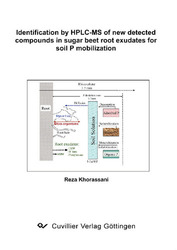| Departments | |
|---|---|
| Book Series (96) |
1378
|
| Nachhaltigkeit |
3
|
| Gesundheitswesen |
1
|
| Humanities |
2362
|
| Natural Sciences |
5406
|
| Mathematics | 229 |
| Informatics | 319 |
| Physics | 980 |
| Chemistry | 1363 |
| Geosciences | 131 |
| Human medicine | 243 |
| Stomatology | 10 |
| Veterinary medicine | 108 |
| Pharmacy | 147 |
| Biology | 835 |
| Biochemistry, molecular biology, gene technology | 121 |
| Biophysics | 25 |
| Domestic and nutritional science | 45 |
| Agricultural science | 1004 |
| Forest science | 201 |
| Horticultural science | 20 |
| Environmental research, ecology and landscape conservation | 148 |
| Engineering |
1790
|
| Common |
97
|
|
Leitlinien Unfallchirurgie
5. Auflage bestellen |
|
Advanced Search
Identification by HPLC-MS of new detected compounds in sugar beet root exudates for soil P mobilization (English shop)
Reza Khorassani (Author)Preview
Table of Contents, Datei (46 KB)
Extract, Datei (110 KB)
Plant species and even varieties of the same species differ in their ability to grow on low P soils, i.e., they differ in their P efficiency. Most P efficient species primarily rely on uptake efficiency, i. e. they can take up almost sufficient P despite low P supply in the soil. With due attention to low soil solution P concentration, this ability can be mainly attributed to chemical mobilization i. e. P
solubilization in soil by root exudates. In order to select a species with high ability to mobilize P sugar beet, maize and groundnut were grown in a fossil Oxisol with low P availability and high P fixing
capacity with three fertilizer treatments of 30, 100 and 1000 mg P kg-1 soil in a growth chamber. Three harvests were performed to cover two different growth periods that may indicate P efficiency changes with age of the plant. At lowest P supply, sugar beet was the most efficient plant among these three species because it had the highest relative yield. Maize was efficient only in medium level
of P, but yield of groundnut was very low at 30 and 100 mg P kg-1 indicating low efficiency as compared to the other two species. The higher P efficiency of sugar beet was due to a higher P uptake efficiency which in turn was due to a high P influx. Under low P supply during the first growing period, P influx of sugar beet was higher than that for maize and groundnut by factor 4 and 22, respectively. Model calculations based on soil parameters and plant P uptake kinetic parameters showed that only if sugar beet increased the P concentration in soil by factor 8 was it possible to explain the observed P influx. This is an indication that sugar beet root exudates solubilized, i.e. mobilized soil P. Therefore the root exudates of sugar beet were analyzed by using a differential
metabolic profiling method with HPLC-MS (High Pressure Liquid Chromatography –Mass Spectrometry) technique. The objective was to find compounds different from the organic acids usually investigated, like citric, malic or oxalic acid, since their effect often seemed not to mobilize P in sufficient amounts. Sugar beet root exudates were collected under low and high P supply
from plants growing in hydroponic system. The HPLC-MS scans of high-P and low-P exudates were compared and 56 and 9 signals were detected for negative and positive ionization modes, respectively, which were at least 5-times higher in low-P than in high-P exudates. Two signals with mass-charge ratio of 137 and 147 were selected for further investigation. Six candidate compounds were selected from KEGG database according to their functional groups and tested for their ability to mobilize P by an incubation experiment in a low P Oxisol. Salicylic acid and citramalic acid of the six compounds increased significantly P concentration in solution above the water control. Further HPLC-MS analysis of the two pure compounds and root exudates confirmed the existence of salicylic
and citramalic acids in the root exudates. The higher intensity of peaks at low-P as compared to high-P samples showed that sugar beet exuded these two organic compounds into the rhizosphere as a response to low P availability. However, other detected HPLC-MS signals under low P conditions indicate that further components of sugar beet root exudates might be also important to mobilize P in soil. The results further show that the metabolic profiling by HPLCMS is a powerful tool to identify compounds relevant to nutrient mobilization in soil.
| ISBN-13 (Printausgabe) | 3867276110 |
| ISBN-13 (Hard Copy) | 9783867276115 |
| ISBN-13 (eBook) | 9783736926110 |
| Final Book Format | A5 |
| Language | English |
| Page Number | 120 |
| Edition | 1 Aufl. |
| Volume | 0 |
| Publication Place | Göttingen |
| Place of Dissertation | Göttingen |
| Publication Date | 2008-06-11 |
| General Categorization | Dissertation |
| Departments |
Agricultural science
|








